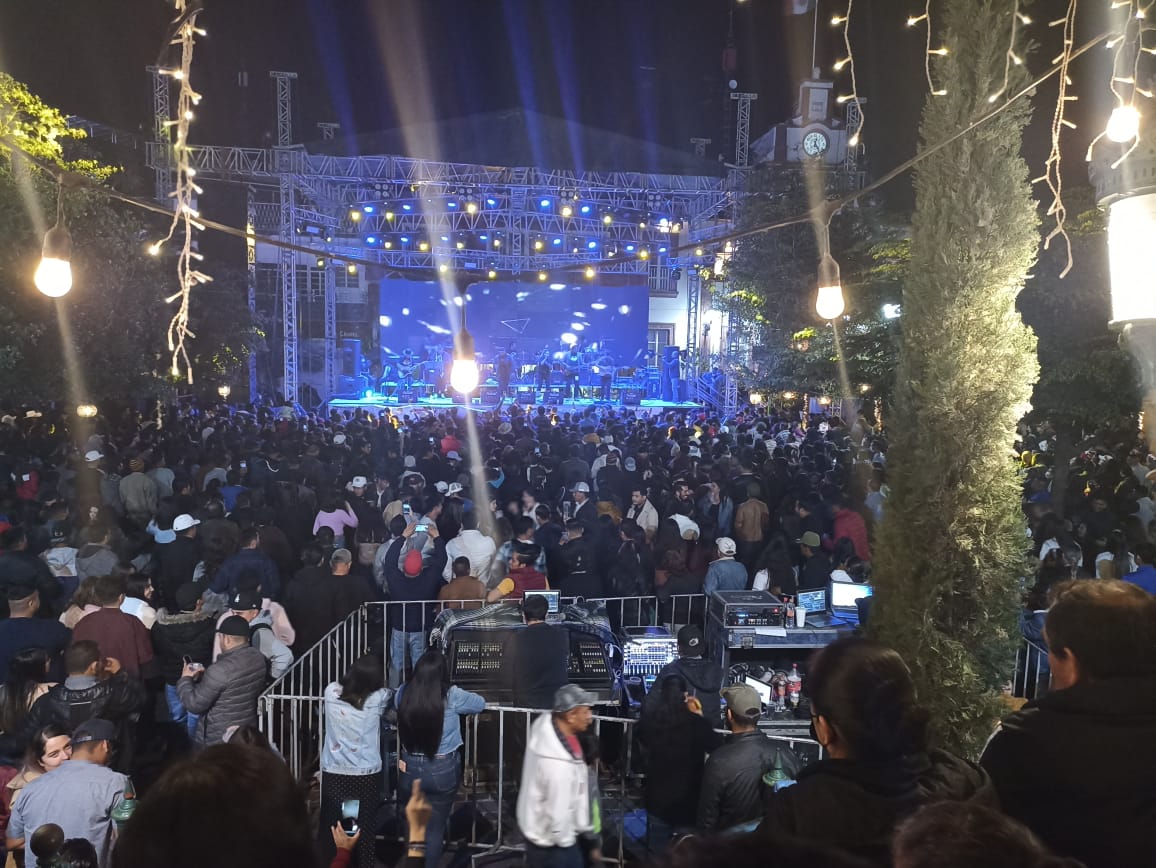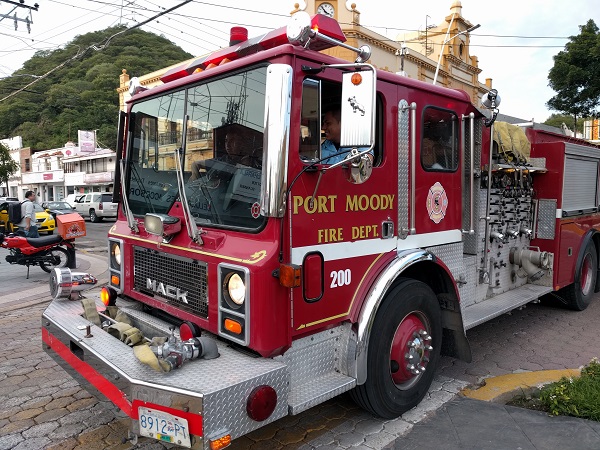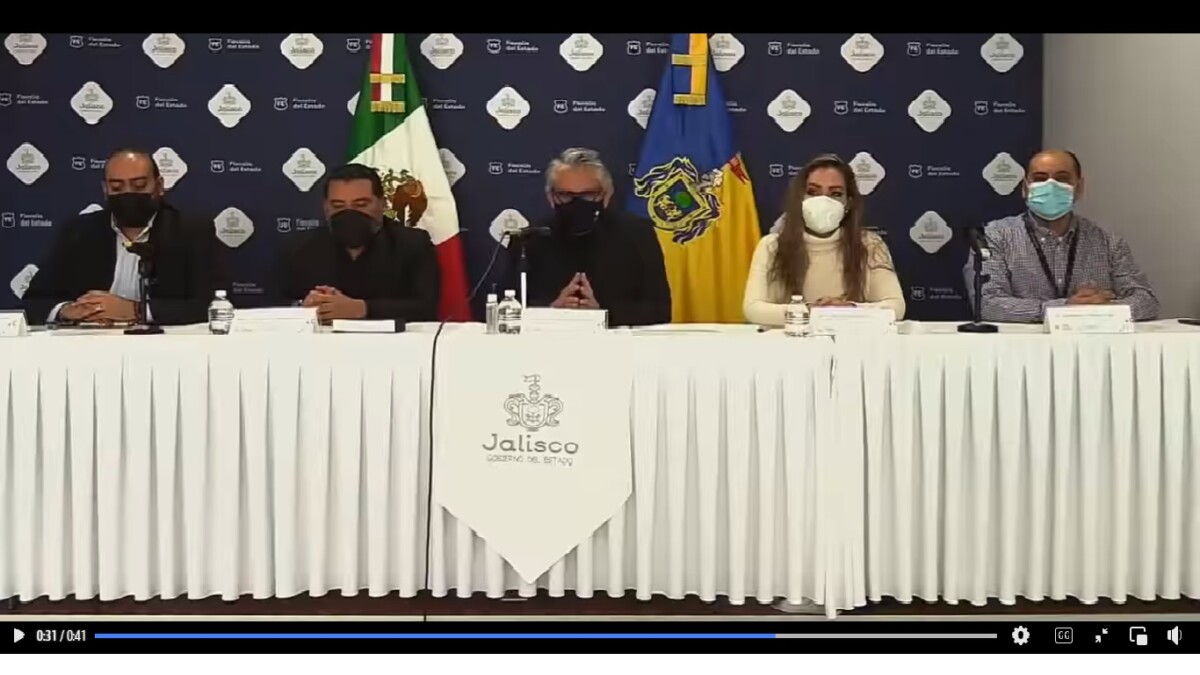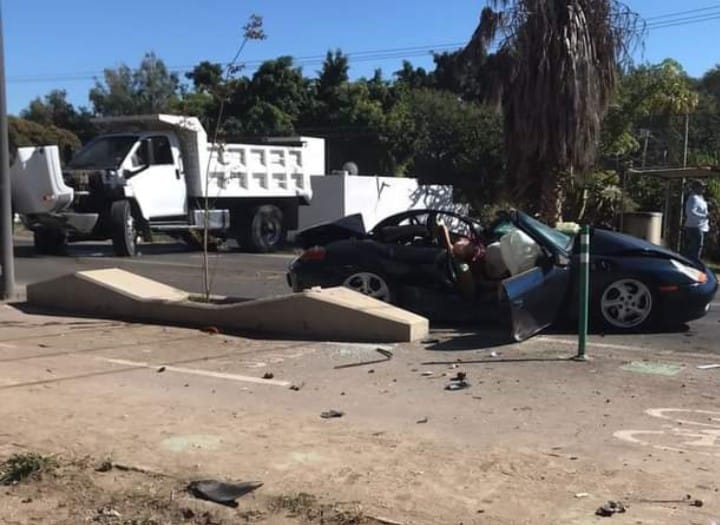en inglés
Coffee, Chocolate and Wine Festival lax with COVID-19 protection measures
During the day there was a large flow of attendees. Due to the constant offering of tests, not everyone wore a mask during their stay at the festival.
Sofía Medeles (Ajijic, Jal.)– In spite of assurances to the press prior to its opening, the Coffee, Chocolate and Wine Festival organizers failed to implement COVID-19 prevention protocols as they had planned.
At the pre-event press conference, event organizer Raúl Ceniceros proposed that event staff would limit and control the capacity of the crowd inside the tent by having only one entrance and one exit, and that they would take temperature checks and enforce the use of face masks for both attendees and exhibitors. However, none of these measures were fully instituted.

The inauguration of the festival was presided over by the mayor of Chapala, Alejandro Aguirre Curiel; the director of tourism, Paola de Watterlot; the head of the Ajijic delegation, Maximiliano Macías Arceo; the municipal trustee Gamaliel Soto Pérez; and the event organizer, Raúl Ceniceros.
The festival, held over two days (January 8 and 9) on the Ajijic boardwalk, was well attended and at times saw hundreds of people crowded together inside the tent. Neither exhibitors nor visitors were required to wear masks, and the public could enter at different points without using antibacterial gel or getting temperature checks. Furthermore, the constant sampling of products on offer at the event was a pretext for many not to use masks.
Event staff stationed at the designated «entrance» to the festival tent, shared that the only instructions they had been given were to ask people entering to wear their masks; to hand out sanitizing spray, and to take peoples’ temperature. They said that overall they had no major problems carrying out the safety measures, except with a few attendees who refused to comply.
From the perspective of exhibitors, however, the festival was a success. Several exhibitors interviewed stated that they are very grateful for events like these, as they provide increased exposure for their products and opportunities for sales at a time when such opportunities are scarce due to the pandemic.

The festival, held over two days (January 8 and 9) on the Ajijic boardwalk, was well attended and at times saw hundreds of people crowded together inside the tent.
«It went very well, we are delighted with the event, the first of this year,” commented an exhibitor from Do Perniler, marketers of Serrano and Iberian hams from Tequisquiapan, Querétaro. “People kept stopping by, everything was very pleasant, and everyone was open to trying our products. It went very well, and Ajijic is a wonderful place; we left very much in love.»
The event, in addition to having samples of food products and wines, also had art and handicrafts for sale. The sixty-six exhibitors included a number of local artisans, such as Luna Cacau.
The head of the Ajijic delegation, Maximiliano «Max» Macias Arceo, assured that while some might look unfavorably on the event due to the circumstances of the pandemic, there were no serious mishaps. He also commented that he viewed the event as positive, in keeping with the promoted theme and of good quality.
Translated by Rebecca Zittle
Jocotepec patron saint festivities continued despite new state mandate
An average of four thousand people participated in the Eclectic Fest 3.0 alone on Monday, January 10. Photo: Courtesy.
Héctor Ruiz Mejía – Despite the increase in the positivity rate from 7.2 percent to 23.4 percent in Jalisco for the coronavirus, the municipality of Jocotepec decided to continue with the festivities for the “Señor del Monte.”
Even though the Health Ministry and the Governor of Jalisco, Enrique Alfaro Ramírez, announced new health measures effective on January 14, in which all types of events such as patron saint festivities, carnivals and massive events were canceled, Jocotepec decided not to cancel the ongoing festivities. «I cannot cancel the entire economy. The decree indicates a start date and it must be an individual choice to attend or not,» said José Miguel Gómez López.
The municipal president explained that the new health measures were announced when the festivities were already well underway. The festival began on January 6th with the “Entrada de Cera” parade, so the festivities were allowed to continue.
«Two years ago when the pandemic started, people did not know how to take care of themselves. Today, the population is aware of the correct safety measures. They already have all the knowledge necessary to protect themselves and can take individual responsibility for whether to go out or not,” added Gómez.
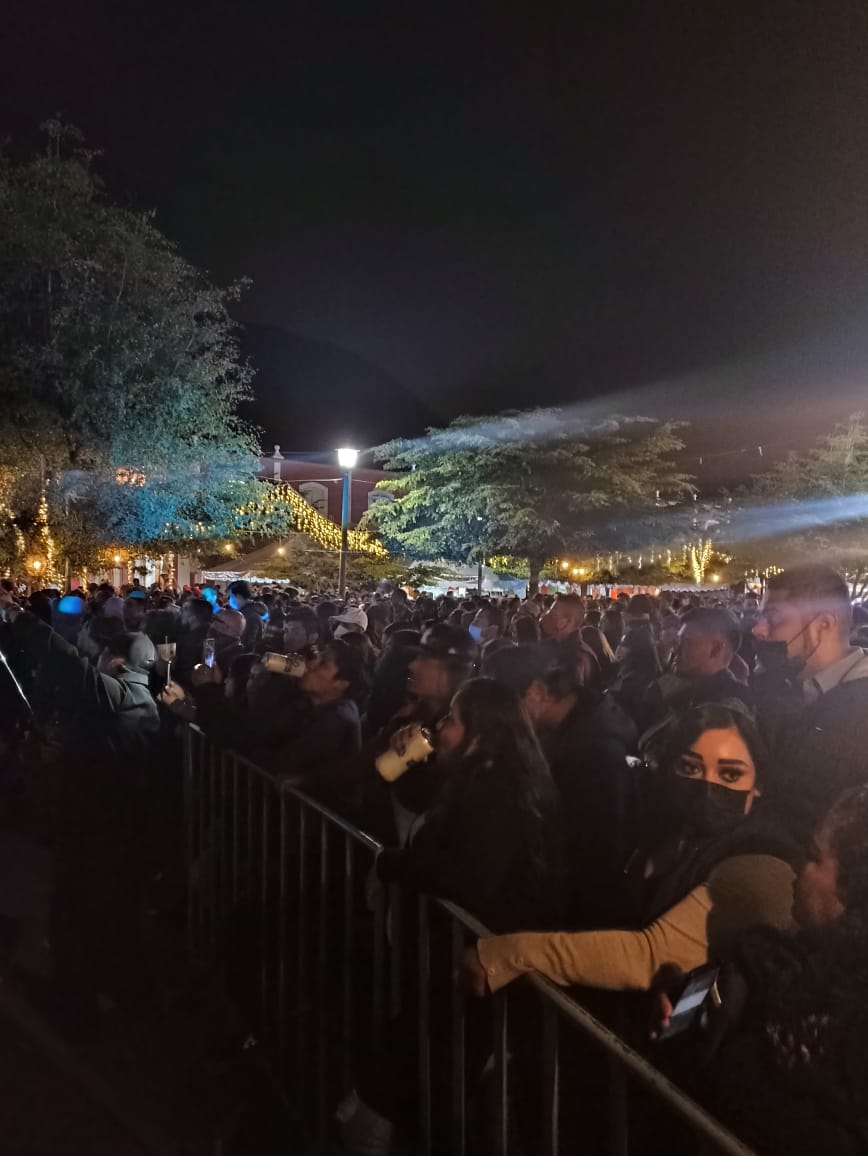
The President of Jocotepec said that it would have been worse to cancel the business generated by the festivities. Photo: Héctor Ruiz.
On Tuesday, January 11, the Civil Protection and Firefighters Unit (UPCB) of Jocotepec, in conjunction with municipal authorities, reported that at least 30 percent of the merchants did not abide by the appropriate safety measures.
«The incidents that persisted the most, where participants were given a warning to comply with the measures, was in the use of masks and antibacterial gel,» explained municipal authorities.
They also explained that skepticism regarding the use of masks and the pandemic itself was prevalent among the elderly, who are one of the segments of the population most vulnerable to the disease.
The municipal president condemned accusations against him for being negligent and irresponsible for allowing the festivities to continue. He pointed out that the municipality has taken all possible measures to safeguard the well-being of the inhabitants of Jocotepec. However, “it is the people who can voluntarily decide to respect the measures or not,” he said.
Translated by Colleen Beery and Kerry Watson
Chapala Fire Department assists in 298 incidents during holiday period
One of the most important emergency trucks in the vehicle fleet of Chapala Fire Department and Civil Protection. Photo: File, Semanario Laguna.
Jazmín Stengel / D. Arturo Ortega – The Chapala Fire and Civil Protection Unit, or UPCB, worked 298 incidents during Operation Joy in Chapala, carried out between December 15 and January 6.
During this period, the Highway Department and the Chapala UPCB reported 27 accidents, three of which were rollovers, another three involved motorcycles and one was a driver pinned in his car. The remaining 20 were “regular” cases, according to the report.
Also reported were 33 pre-hospital care and four emergency transfers outside the municipality, in addition to the care of three deceased persons and four rescues, of which one was a water rescue. There were also 18 fires, seven of which resulted in material losses, according to the Chapala Fire Department report.
The amount of illegal pyrotechnics in the municipality has also decreased. In the first nine days of the operation, the UPCB reported seizing 14 kg of pyrotechnics, while in previous years they seized as much as 80 kilograms (2018-2019), as reported by Semanario Laguna in its January 6 edition.
The UPCB reported only three pyrotechnics seizures during the holiday season that extends from the December 12 fiesta de la Virgen de Guadalupe through the January 6 day of the Three Kings. Weyler Samuel Ruíz, in charge of the unit, said they added up to at most 250 grams of gunpowder. This is because the neutral material, such as paper and wood, is not included in the weight because the only illegal substance is the gunpowder, “and this is usually very little,” said Ruíz, referring to the amount contained in each rocket.
On the other hand, two businesses were reprimanded during the operation’s holidays, both for being open too late and allowing loud music over the decibel limit. Both businesses are in Ajijic and belong to the bar-cantina business.
Translated by Mike Rogers
Opinion: Looking at life in Lakeside
By Patrick O’Heffernan
Michi-Cihualli is the mythological goddess who symbolizes the essence of the waters and lands of Lake Chapala. According to the legend, she is the mediator of good weather and the queen of the wind- she blows the gales of the four cardinal points, enabling the fishermen to know the direction of the squalls on the lake and t and farmers the good weather for corn.
But an important part of the legend of Michi-Cihualli is her first appearance: when the ruling tribe practiced human sacrifice and threw children into hot springs, Michi-Cihualli became enraged and created powerful winds, whirlpools, clouds of ash and eventually an earthquake to stop the desecration of her waters.
We don’t sacrifice humans any more, but we are sacrificing the Lake itself and the Ribera – the lands of Lake Chapala — with pollution, traffic, illegal development, and poverty. And Michi-Cihualli is again blowing her powerful breath over the lake in warning, only this time it is not winds she is raising, but a rekindling of the values she taught and resistance to those who would float them.
Next week, on January 20, 21, and 22, her winds will gust from one of her spiritual homes in Ajijic, La Cochera Cultural, in a three-day Festival of Michi. A residence for artists of all kinds, La Cochera Cultural is curated by Antonio López Vega, an artist who has spent a lifetime capturing and chronicling the spirit of Michi-Cihualli in painting and sculpture. The Festival he is curating at La Cochera Cultural will use film, art, music, dance, and discussion to explore the spirit and lessons of Michi-Cihualli and what is happening today in Ajijic.
In a separate but parallel effort, a group of musicians and artists are considering a concept paper Espiritu de Music y Art, to bring the lifeforce of Michi-Cihualli to Ajijic and San Antonio-Tlayacapan all year round through a marriage of art and music. They are responding to call by Ajijic Culture Director Santiago Baeza (who has just resigned) for events at local venues bringing together two of Ajijic’s greatest assets: artists and musicians.
In another separate but parallel effort, the Pueblo Mágico Ajijic Committee is anticipating an infusion of money for ventures enhancing and promoting the magic of the pueblo. While it waiting for funds, the Committee is developing plans and evaluating projects for their contribution to the Pueblo Mágico designation.
Couple charged in death of a child
Sofía G., mother of the child, and her partner, Marcos Alberto G., were under the influence of narcotics at the time of the crime.
The mother of a 14-month boy and her partner have been charged with parricide, which is murder of a close relative, and aggravated homicide in the boy’s recent death.
The investigation by the Regional Prosecutor’s Office assigned to Chapala found that on December 31, Sofia G., the boy’s mother, and her partner, Marcos Alberto G., were under the influence of narcotics in a home on Hidalgo street in Chapala’s Atotonilquillo neighborhood. The investigation revealed that the child began to cry because he was hungry. The accused hit the child repeatedly and threw him onto the floor. He sustained a skull fracture that caused his death.
When the prosecutor’s office learned of the child’s death, an investigation began that led to a judge approving an arrest warrant against the couple. After evidence was gathered, the mother and her partner went before the judge, who decided to commit them to trial for the crime of parricide and ordered them to serve one year of official preventive detention as a precautionary measure.
Translated by Mike Rogers
Runaway children found in Jocotepec
Technical data sheets of children who escaped from the shelter.
Four minors were found on an abandoned farm in Jocotepec, after being sought by the authorities after escaping from a shelter in Guadalajara.
Three children, Nadia, age 15, Ximena, age 13, and Elizabeth, age 17, were located on Monday. The following day Diana, 16 years old, was also located. The minors were taken to the medical area of the Special Prosecutor’s Office for Missing Persons.
The search to find the whereabouts of the four minors began on December 29, when the staff of the children’s shelter where they were staying noticed their absence and filed a missing persons report.
Translated by Colleen Beery
Chronicles of the Ribera
The volunteers place the sawdust in a four to five-hour day
By: María del Refugio Reynozo Medina
I do not know exactly when these walls first witnessed the hymns and songs of fervor to the Virgin of Guadalupe. My grandparents who were born here in 1917, had memory of it. In my town it seems that the whole altar shakes with the sounds of the band. Every December 30 after six in the morning, when the musicians sing the waltzes, pasodobles and the mañanitas around the dark-haired image that on the penultimate day of the year is still being celebrated, something happens in the hearts of those born here.
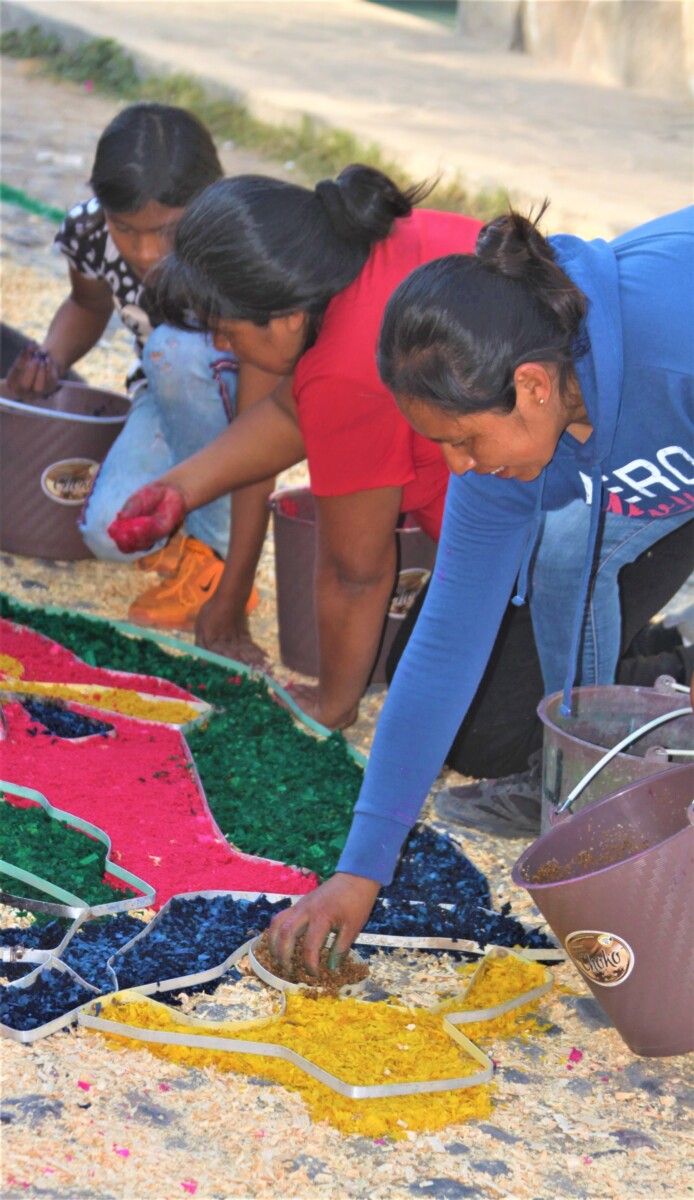
Most of the volunteers are women.
More than two hundred roses, carnations and chrysanthemums frame the image on a small platform. At four o’clock in the afternoon the streets are buzzing with people wandering around with a festive air.
Outside a house, a family prepares an arch supported by metal bars and lined with bouquets of fresh flowers and intertwined fabrics, as they drink from their glasses, chat and laugh. Two streets ahead, a man briskly throws buckets of water onto the swept cobblestone street. The scent of wet earth lingers for more than a block during my walk. In another house, a woman places a bouquet of flowers on a small improvised altar outside her home.
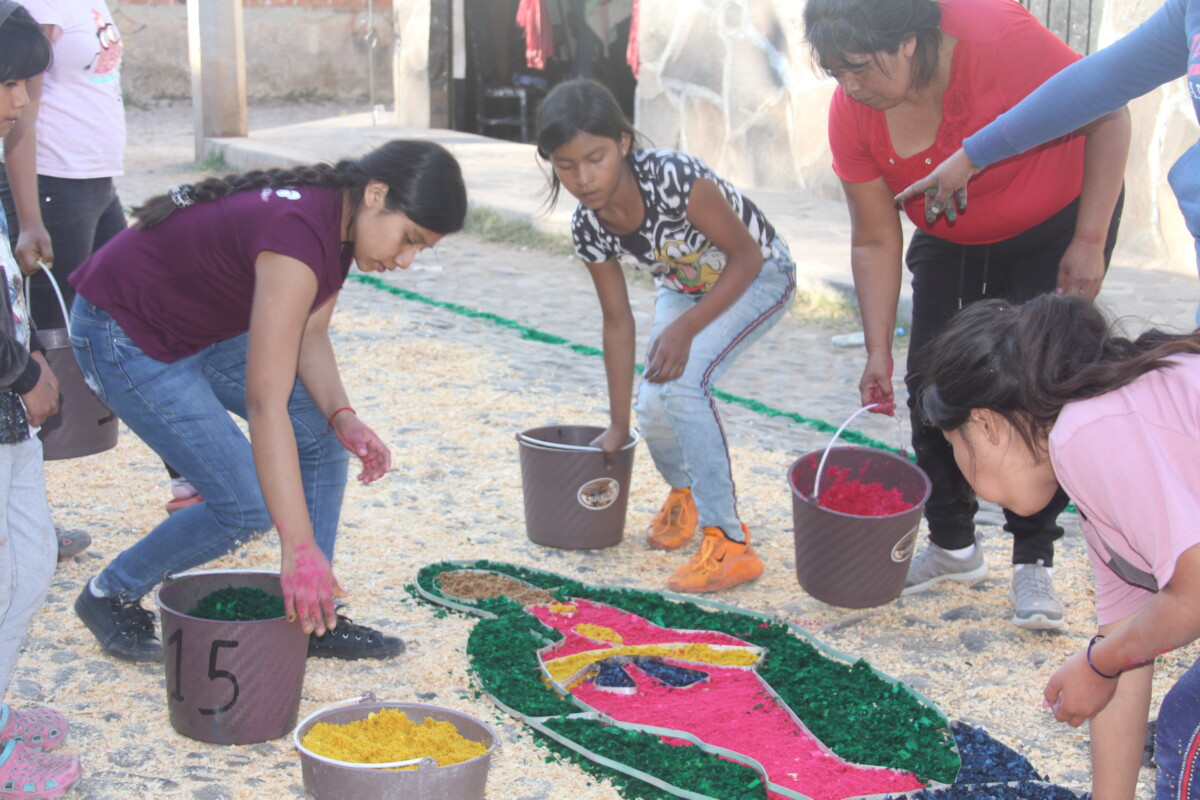
The women organize themselves to spread the different colors.
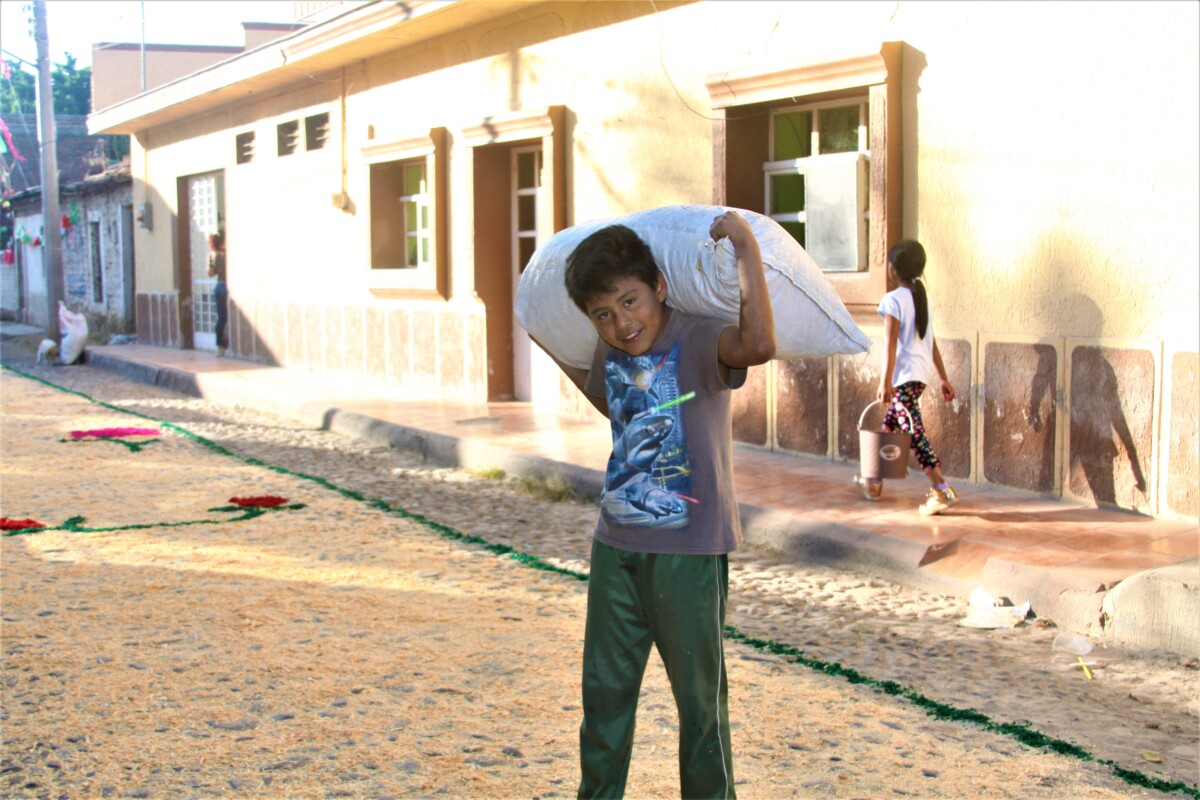
A boy carries a sack of sawdust.
In this neighborhood that people call slum, black bags with garbage lie next to the streets. Other bags and boxes with garbage are at the entrance of the houses. In some of them there is a smell of decomposition. A woman says that the last day the municipal garbage truck passed by was more than seven days ago.
The sprawling garbage also greeted the passing of the image during the procession.
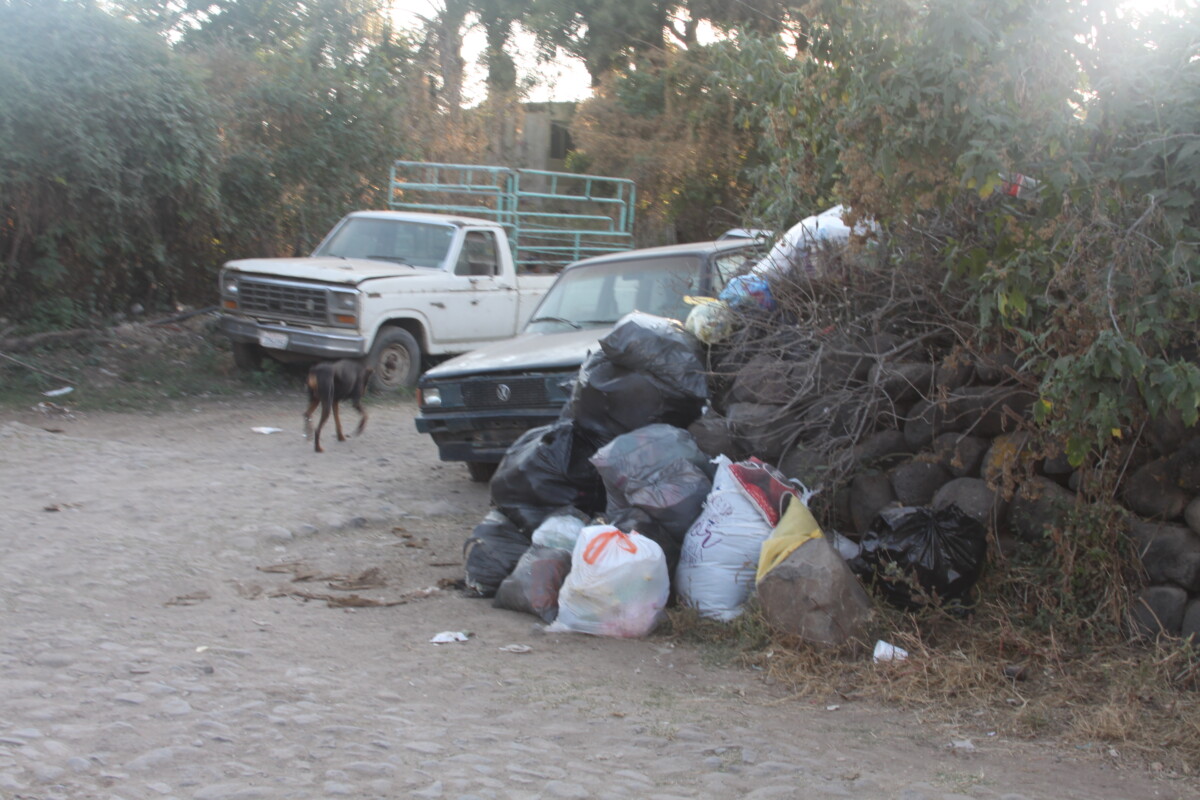
Next to the decorated and swept streets, there are bags with garbage.
On Ramón Corona Oriente Street a group of people spread dyed sawdust to form a mosaic with the image of the Virgin of Guadalupe and added bouquets of roses. The mosaic carpet covers about four blocks which have been closed to traffic by the organizers. The volunteers are armed with wheelbarrows, buckets and sacks filled with multicolored sawdust, and they walk through the streets embroidering the cobblestone street with wood dust.
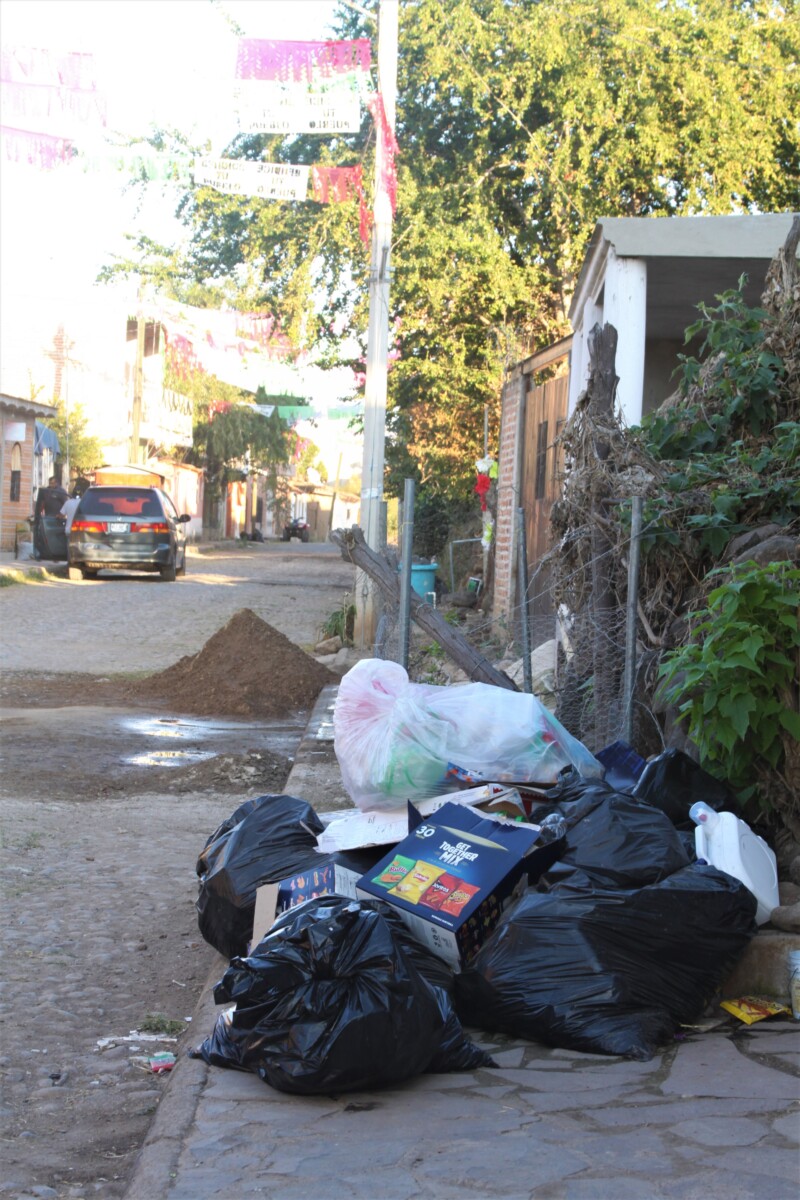
According to the testimony of a neighbor, the City Hall collection truck has not come for more than 7 days.
On Porfirio Diaz Street, a group of young people and children assemble another sawdust mat with the image of the Virgin of Guadalupe and more roses. A girl about six years old walks with a small bucket and sprinkles sawdust. On the corner, another arch of fresh flowers progresses. A man on the same street nails a canvas with the image of the Virgin of Guadalupe to the wall, and places colored lights around it.
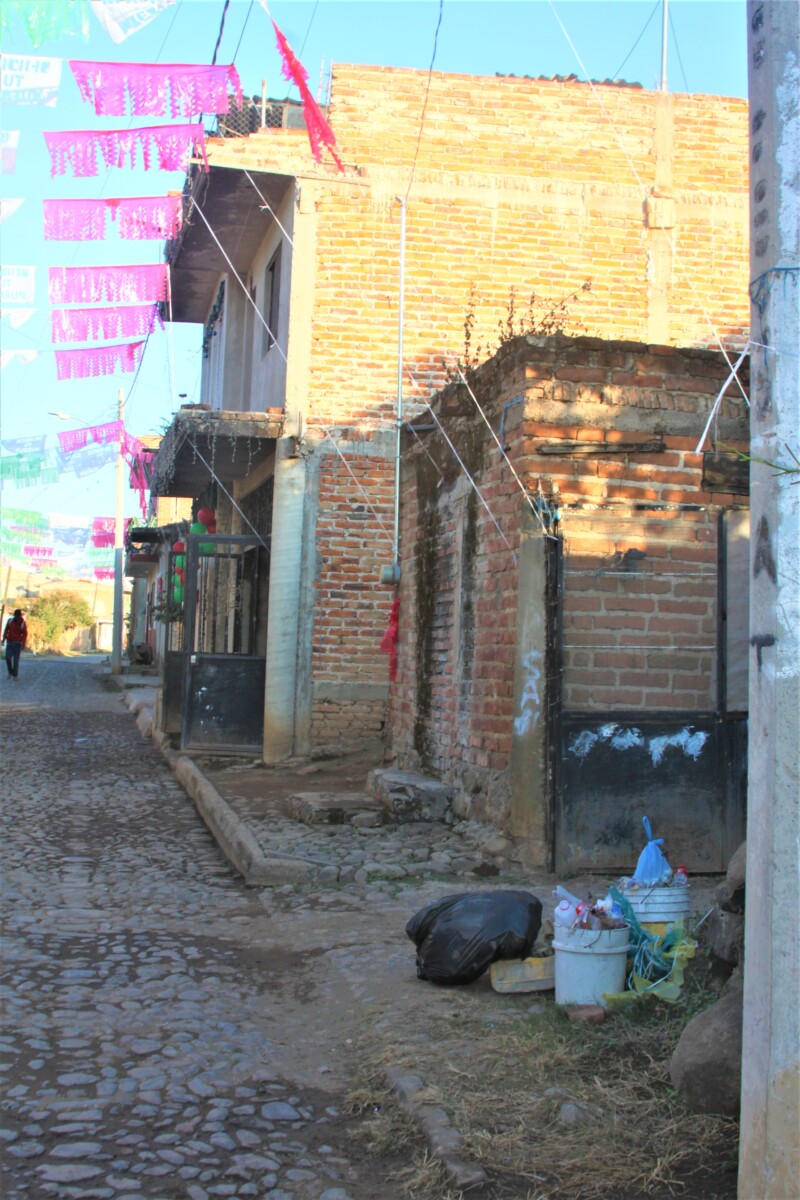
The decorated ribbons contrast with the straggling garbage bags.
The mayor, Rosa Villa, sent for a tow truck to remove the vehicles that do not comply with the instructions to clear the main streets.
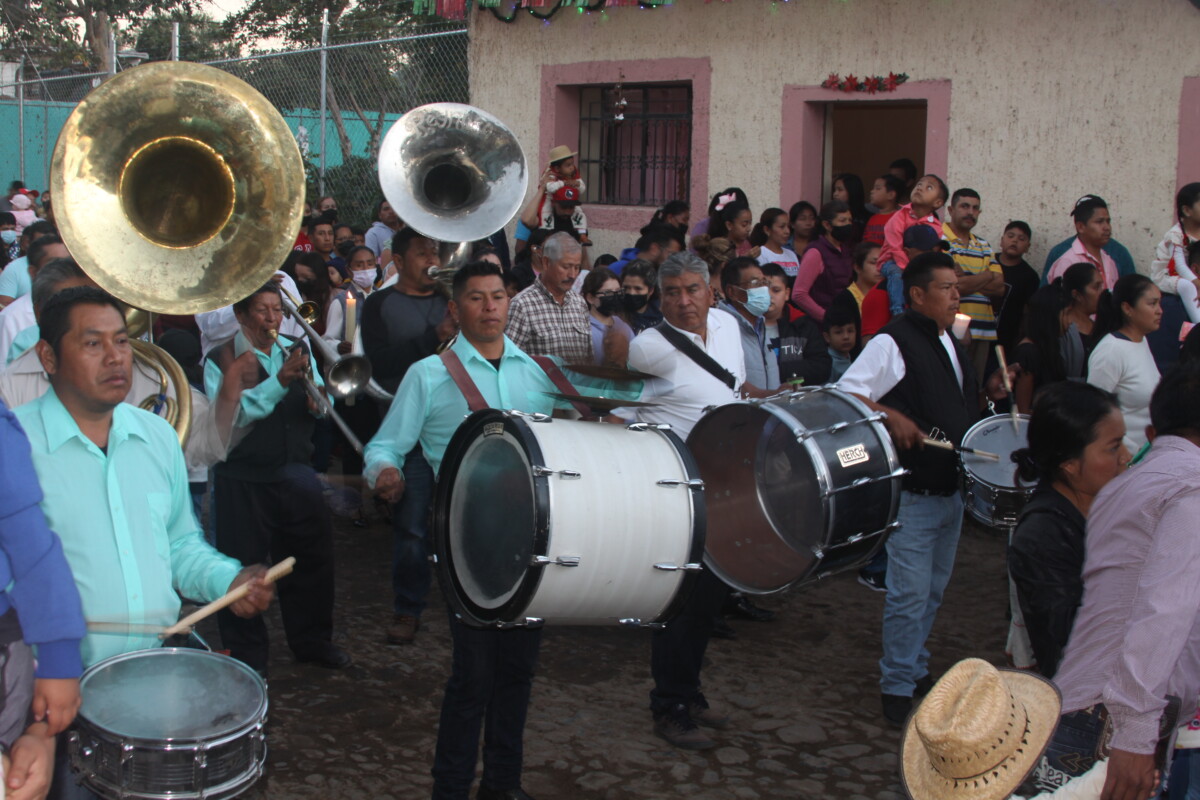
Musicians play throughout the procession.
At six o’clock in the afternoon the first call is heard and people begin to pass by and head to the temple. There are women wearing blouses with ethnic touches, girls dressed as the Virgin of Guadalupe, children with blanket attire and tilmas with the image of the Virgin of Tepeyac.
At the front of the procession goes the dance, two young men carry a drum that they beat with force from time to time. Next, the group of dancers emits a sharp shout to then execute the series of dances of the ritual. The group of over 500 worshippers with their white flags is in the procession and at the end of the procession, the music band.
It begins to get dark and the faces of some pilgrims are illuminated by the lighted candles in their hands.
When arriving at the temple, the picture with the image is lowered from the platform and taken to the altar amidst the burning wicks and looks of fervor. The musicians enter playing the Guadalupan Hymn, the bright feathers of the dancers move to the beat of the drum and the conch shell and the faithful break into applause, some to tears.
The walls of the temple shake again and the image rests on its throne of flowers.
Translated by Sydney Metrick
Parents of child found dead in Atotonilquillo charged
At a press conference the Jalisco Prosecutor’s Office confirmed the indictment of the parents of the child for the crime of parricide and homicide.
Editor. – The Jalisco State Prosecutor’s Office held a press conference to announce that the parents of Angel Isaac, a child from Atotonilquillo, have been charged with parricide and homicide. The body of the one year old child was found inside a farm in Atotonilquillo, in the municipality of Chapala, where the child lived with his mother and two men.
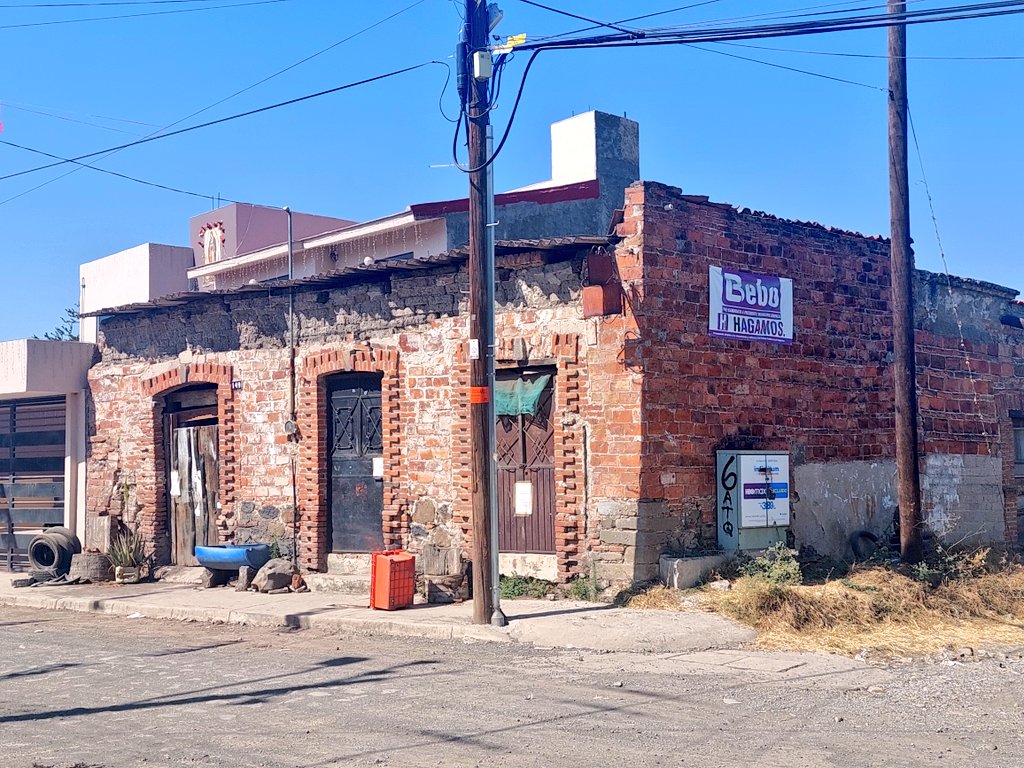
House where the one-year-old child lived
First reports indicated that the child’s body showed traces of torture and sexual abuse, but the Jalisco Prosecutor, Gerardo Octavio Solis Gomez, attributed the cause of death to cranial encephalic trauma. The Prosecutor’s Office explained that experts investigating the case have ruled out any kind of sexual abuse. The parents could be sentenced to up to 45 years in prison.
In another case, an eight year old child was found dead on the night of December 31, at the corner of Herrera and Hidalgo streets. A woman has been arrested who is reported to be mentally ill.
Translated by Elisabeth Shields
Porsche Driver Dies After Collision with Heavy Truck
The driver of the luxury car died instantly.
A fatal collision occurred on the Chapala-Jocotepec highway at the entrance to Canacinta in West Ajijic, where a Porsche was totaled after crashing into a heavy truck. The deceased is a U.S. citizen, whereas the driver of the truck is unknow, having fled from the scene.
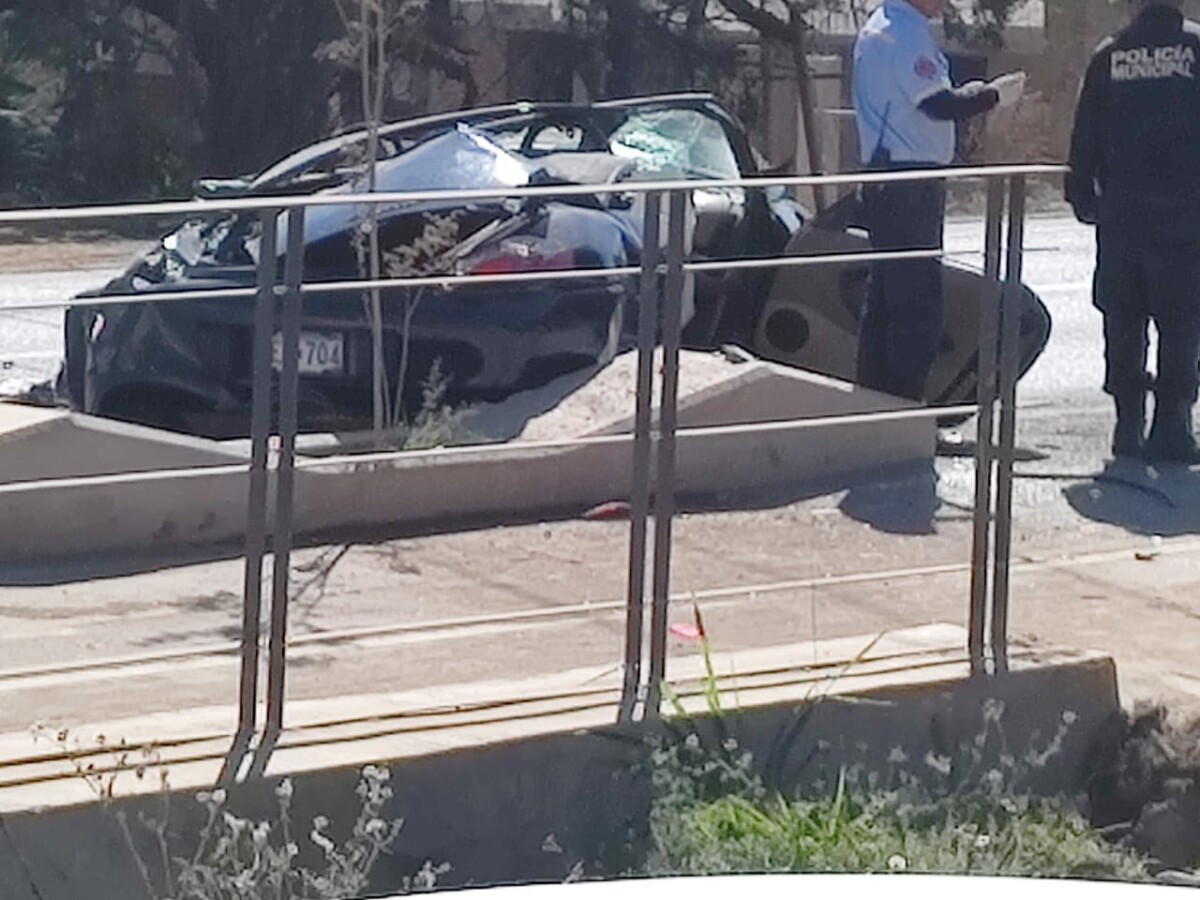
The accident caused a traffic jam.
The accident occurred on the afternoon of Thursday, January 6, and emergency responders arrived at the scene. Nothing could be done for the driver, who died instantly during the crash, so his body was collected by the Instituto Jalisciense de Ciencias Forenses (Jalisco Institute of Forensic Sciences).
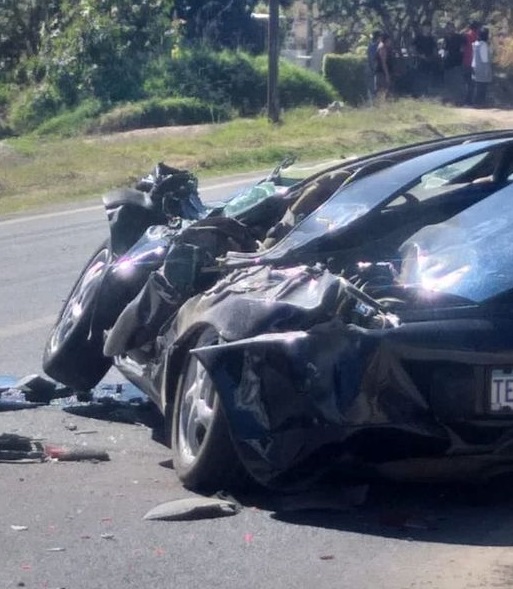
The vehicle was totaled.
The incident caused traffic chaos in the area, since the highway was partially blocked by the damaged black luxury car and the white heavy truck.
Translated by Colleen Beery
Tax collection begins with discounts of up to 50 percent in Chapala
Payment window at Chapala City Hall and taxpayers waiting for their turn.
Editor / With contributions from Jazmín Stengel. – Discounts on property tax of fifty-, fifteen- and five percent will be offered by the Municipality of Chapala for those who pay their property tax on time, from January to April 2022. Additionally, a fifteen percent discount is being offered to those who pay their potable water service bills during the month of January. The fifty percent discount on property tax will be applied to pensioners, retirees, people with disabilities, widows, widowers and people over 60 years of age.
The Municipality of Chapala, through its Social Communication Department, stated that four collection boxes and four collection terminals have been set up in the Municipality of Chapala facilities located at Avenida Francisco I. Madero 202, as well as a mobile box that will go to condominiums and ‘cotos’ so that people do not have to go to the municipal capital to make their payments.
So far the response to the tax initiative has been positive, although no official tally has been made as to how much municipal coffers have taken in during the first days of the year. In the next few days, the municipality expects to activate a digital platform so that citizens, who do not want to go in person to the City Hall facility, can pay their property tax from the comfort of their homes. The online option will not be available for water bills, however.
The Municipality says that the payment process has been operating very smoothly, and facilities are complying with sanitary measures to avoid the spread of the coronavirus. People will not have to wait long to make their property tax and water payments.
As noted, pensioners, retirees, people with disabilities, widows, widowers and people over 60 years of age are eligible for the fifty percent discount on property tax. A discount of fifteen percent will be applied to general citizens who make their property tax payments during the months of January and February, and a five percent discount will be applied to those who pay during the months of March and April.
The fifteen percent discount on payments of potable water bills will apply for taxpayers only during the month of January.
Payments may be made at the windows from Monday to Friday, from 9:00 a.m. to 2:45 p.m. and on Saturdays from 9:00 a.m. to 1:00 p.m.
Translated by Rebecca Zittle
© 2016. Todos los derechos reservados. Semanario de la Ribera de Chapala

